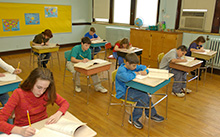What can teachers do to improve their students’ reading comprehension?
Page 8: Wrap Up Strategy
 After they’ve finished the passage, students are ready to implement the Wrap Up strategy. The purpose of the Wrap Up strategy is to help students to understand and remember what they have learned. The general procedure requires two steps: generate questions and review important ideas.
After they’ve finished the passage, students are ready to implement the Wrap Up strategy. The purpose of the Wrap Up strategy is to help students to understand and remember what they have learned. The general procedure requires two steps: generate questions and review important ideas.
Wrap Up Strategy
Activities: generate questions and review important ideas
Teachers start by asking students to imagine that they are teachers trying to write test questions based on the text’s content.
- Generate and answer questions from text:
- Students brainstorm a number of possible questions and write them in their learning logs in the Wrap Up section under Questions about the important ideas in the passage.
- The students then arrange the questions according to a question hierarchy that reflects lower-to-higher order thinking.
Question Hierarchy
- The answer is in the text and can be stated in one or two words.
- The answer is in the text but requires more than a couple of words to answer.
- The answer is in the text but not all in the same place. The reader has to synthesize the parts in order to arrive at the correct answer.
- The reader has to synthesize his or her prior knowledge with the text content in order to answer the question.
- Students should next try to answer the questions. A question that cannot be answered might not be a good question or might require clarification.
- Review what was learned:
- Students write down the most important ideas from the day’s reading in their learning logs in the Wrap Up section under What I learned. This requires them to mentally organize the information and to focus on comprehending the text as a whole.
- Students take turns sharing with the rest of the class what they consider to be their best ideas.
Ecosystems: Making Connections
An ecosystem is part of the environment. In an ecosystem, big and small animals live in harmony with the rest of their natural world. A shoreline is one kind of ecosystem. Other kinds include deserts and rain forests. The parts of an ecosystem rely on each other for the health of the environment. That means that if one part is damaged, the balance of the whole can be upset. If this damage is big enough, the ecosystem might even collapse.
To help you understand ecosystems, you might imagine a spider-web. All of its threads are connected. If one part breaks or is torn, the rest of the web is weakened until it can be repaired.
Click here to view a sample learning log with the wrap up filled in.
Students often have difficulty generating effective questions from text, so it may take some time for them to learn this essential comprehension skill.
Click on the movie to watch some students implementing the Wrap Up strategy (time: 0:38).
“Copyright © by the Texas Education Agency and University of Texas at Austin. All rights reserved” on all Licensed Materials.
Transcript: Wrap Up Strategy
Narrator: After reading several paragraphs, it’s time for Wrap Up. Students generate questions to review key ideas they have read.
Student #1: “Remember to start your questions with who, when, what, where, why, or how.”
Voiceover: Students write the questions in their learning log. Then they share them with the group, working together to find answers in the text, and summarize what they have learned.
Student #1: Okay, Brandon.
Student #2: “What was Santa Ana’s new state?”
Student #3: I know. It’s right here. “No Mexican children were even assigned to watch.”
Student #1: “In our learning logs, let’s write down what we learned.”